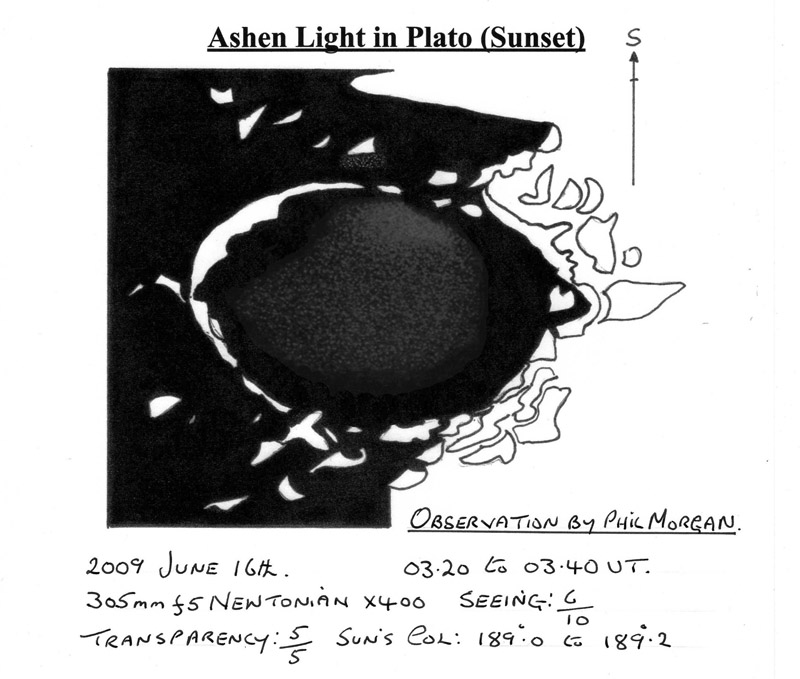October 29, 2018
Milk of Plato
Originally published August 15, 2009

image by Phil Morgan (the floor is not black, tilt your laptop screen to see it properly).
Whilst studying the Moon in the early hours of June 16th 2009 at 03.20 UT, I was confronted with one of the strangest sights that I have seen – much of the floor of Plato appeared to be covered in a milky white light. Transparency was perfect and a check to see if the effect was apparent in any other crater proved negative, so I quickly attempted to draw what I could see as daybreak had already set in. The area under the inner south west rampart was the brightest and it was thought at first that this represented some slightly higher ground catching the glancing solar rays, but a study of images and earlier drawings indicated that this part of Plato’s floor had long been engulfed in deep shadow. It seems more likely that this was a case of reflected light, probably from some peaks near to the brightest area, the southwest. A single brightly illuminated peak probably wouldn’t explain my observation, since reflected light would fall off in brightness in line with the inverse square law, and if so would probably produce sharp edges to the illuminated region. In the case of the south polar crater Shackleton, the Kaguya probe was able to see inside this permanently shaded crater using the reflected light technique, so this theory seems possible. Although my observation at first sight seemed unique, it is a fact that this effect has been recorded a number of times in the past, starting with SchrÖter’s "kind of fermentation on the floor of Plato" of 1789, and W.R. Birt’s impression "that a kind of sparkling or agitation played over the dark floor deep in shadow", on November 20th 1871. In 1882, March 27 at 8h 10m, A. Stanley Williams noted that " three quarters of the floor in shadow seemed to glow with a curious, luminous, milky kind of light". More recently, B. Hobdell (St Petersburg, FL, USA.) on October 21st 1981 at 11:35UT, noted that a peak south of the crater floor glowed white, then a milky shade spread all around Plato’s floor (previously completely shadow filled). The cloud like feature was washed out by daylight at 11:48UT. No doubt there are more similar reports waiting to be unearthed, but the next development would be an image of this effect, and hopefully my observation will encourage imagers to make a special study of Plato just before sunrise and just after sunset when lighting is sufficiently oblique for the event to occur.
Phil Morgan
Technical Details
See drawing
Related Links
Rükl plate 3
I must express my thanks to the following for their help and useful suggestions: John Moore, Tony Cook, Richard Baum, Nigel Longshaw, Peter Grego, Bill Leatherbarrow and Colin Ebdon.
Yesterday's LPOD: A Well Dressed Well
Tomorrow's LPOD: Big Bounce
COMMENTS?
Register, Log in, and join in the comments.



